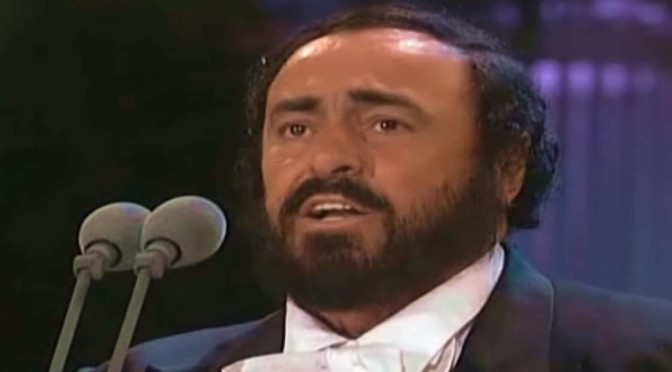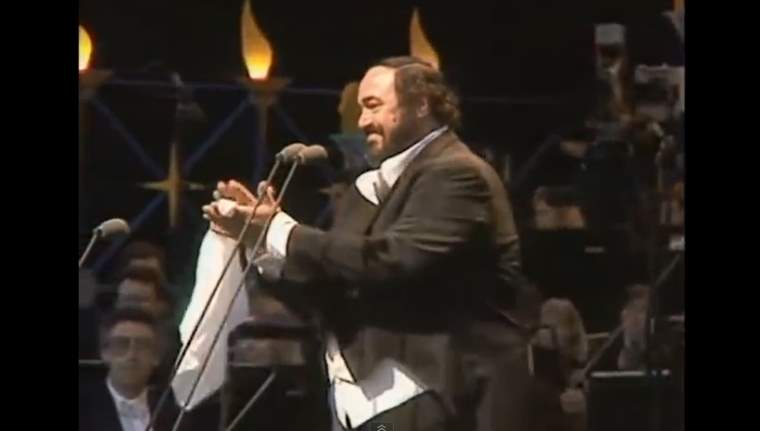The legendary Italian tenor Luciano Pavarotti sings Franz Schubert’s “Ellens dritter Gesang” (“Ellens Gesang III”, D. 839, Op. 52, No. 6, 1825, English: “Ellen’s Third Song”), popularly known as “Ave Maria”. From the Three Tenors concert in Los Angeles, 1994. Los Angeles Philharmonic Orchestra conducted by Zubin Mehta.
Ave Maria
The piece was composed as a setting of a song (verse XXIX from Canto Third) from the Scottish historical novelist, playwright, and poet Walter Scott’s (15 August 1771 – 21 September 1832) popular epic poem The Lady of the Lake, in German translation by the German educator and historian Adam Storck (16 October 1780 – 19 April 1822), and thus forms part of Schubert’s Liederzyklus vom Fräulein vom See.
In Scott’s poem the character Ellen Douglas, the Lady of the Lake (Loch Katrine in the Scottish Highlands, a freshwater loch in the district of Stirling, Scotland), has gone with her exiled father to stay in the Goblin’s cave as he has declined to join their previous host, Roderick Dhu, in rebellion against King James. Roderick Dhu, the chieftain of Clan Alpine, sets off up the mountain with his warriors, but lingers and hears the distant sound of the harpist Allan-bane, accompanying Ellen who sings a prayer addressed to the Virgin Mary, calling upon her for help. Roderick Dhu pauses, then goes on to battle.
Schubert’s arrangement is said to have first been performed at the castle of Countess Sophie Weissenwolff in the little Austrian town of Steyregg and dedicated to her, which led to her becoming known as “the lady of the lake” herself.
The opening words and refrain of Ellen’s song, namely “Ave Maria” (Latin for “Hail Mary”), may have led to the idea of adapting Schubert’s melody as a setting for the full text of the traditional Roman Catholic prayer Ave Maria. The Latin version of the Ave Maria is now so frequently used with Schubert’s melody that it has led to the misconception that he originally wrote the melody as a setting for the Ave Maria.
“Ave Maria” is one of the most popular songs in the world, although often sung to words different from those of Schubert/Storck/Scott, or performed in instrumental versions with no words at all.
Here is another version from Pavarotti below. A Christmas Special from 1978.
Loch Katrine

Loch Katrine is a freshwater loch in the district of Stirling, Scotland. It is roughly 8 miles long by 2/3 of a mile wide and runs the length of Strath Gartney. It is a popular destination for tourists and day visitors from Glasgow and other nearby towns. The loch derives its name from the term cateran from the Gaelic ceathairne, a collective word meaning cattle thief] or possibly peasantry. Historically this referred to a band of fighting men of a clan; hence the term applied to marauders or cattle-lifters, the most notorious of whom was Rob Roy MacGregor who was born at Glengyle House at the northern end of the Loch.
It is the fictional setting of Sir Walter Scott’s poem The Lady of the Lake and of the subsequent opera by Gioachino Rossini, La donna del lago.
Lyrics
“Hymn to the Virgin” by Sir Walter Scott
Ave Maria! maiden mild!
Listen to a maiden’s prayer!
Thou canst hear though from the wild;
Thou canst save amid despair.
Safe may we sleep beneath thy care,
Though banish’d, outcast and reviled –
Maiden! hear a maiden’s prayer;
Mother, hear a suppliant child!
Ave Maria
Ave Maria! undefiled!
The flinty couch we now must share
Shall seem with down of eider piled,
If thy protection hover there.
The murky cavern’s heavy air
Shall breathe of balm if thou hast smiled;
Then, Maiden! hear a maiden’s prayer,
Mother, list a suppliant child!
Ave Maria!
Ave Maria! stainless styled.
Foul demons of the earth and air,
From this their wonted haunt exiled,
Shall flee before thy presence fair.
We bow us to our lot of care,
Beneath thy guidance reconciled;
Hear for a maid a maiden’s prayer,
And for a father hear a child!
Ave Maria.
Storck’s translation used by Schubert
Ave Maria! Jungfrau mild,
Erhöre einer Jungfrau Flehen,
Aus diesem Felsen starr und wild
Soll mein Gebet zu dir hin wehen.
Wir schlafen sicher bis zum Morgen,
Ob Menschen noch so grausam sind.
O Jungfrau, sieh der Jungfrau Sorgen,
O Mutter, hör ein bittend Kind!
Ave Maria!
Ave Maria! Unbefleckt!
Wenn wir auf diesen Fels hinsinken
Zum Schlaf, und uns dein Schutz bedeckt
Wird weich der harte Fels uns dünken.
Du lächelst, Rosendüfte wehen
In dieser dumpfen Felsenkluft,
O Mutter, höre Kindes Flehen,
O Jungfrau, eine Jungfrau ruft!
Ave Maria!
Ave Maria! Reine Magd!
Der Erde und der Luft Dämonen,
Von deines Auges Huld verjagt,
Sie können hier nicht bei uns wohnen,
Wir woll’n uns still dem Schicksal beugen,
Da uns dein heil’ger Trost anweht;
Der Jungfrau wolle hold dich neigen,
Dem Kind, das für den Vater fleht.
Ave Maria!
Latin Catholic prayer version
Ave Maria, gratia plena,
Maria, gratia plena,
Maria, gratia plena,
Ave, Ave, Dominus,
Dominus tecum.
Benedicta tu in mulieribus, et benedictus,
Et benedictus fructus ventris (tui),
Ventris tui, Jesus.
Ave Maria!
Sancta Maria, Mater Dei,
Ora pro nobis peccatoribus,
Ora, ora pro nobis;
Ora, ora pro nobis peccatoribus,
Nunc et in hora mortis,
In hora mortis nostrae.
In hora, hora mortis nostrae,
In hora mortis nostrae.
Ave Maria!
Latin Catholic prayer version (English translation)
Hail Mary, full of grace,
Mary, full of grace,
Mary, full of grace,
Hail, Hail, the Lord
The Lord is with thee.
Blessed art thou among women, and blessed,
Blessed is the fruit of thy womb,
Thy womb, Jesus.
Hail Mary!
Holy Mary, Mother of God,
Pray for us sinners,
Pray, pray for us;
Pray for us sinners,
Now, and at the hour of our death,
The hour of our death.
The hour, the hour of our death,
The hour of our death.
Hail Mary!
Sources
- Ave Maria on Wikipedia
- Loch Katrine on Wikipedia


